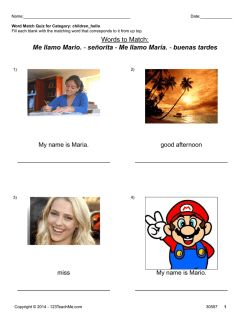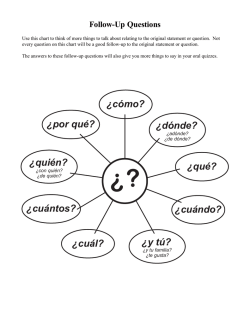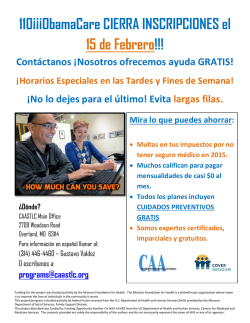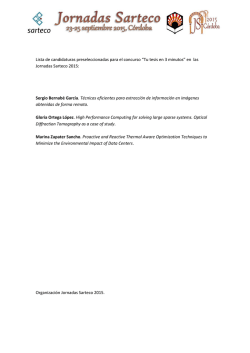
Pepito el nino precoz - msbarrios
Antes de leer ESTRATEGIA para leer To improve your comprehension as you read a story, stop after each paragraph or section and ask yourself the who, what, where, when, and why of the story. Focusing on these questions as you read will not only help you check your comprehension, but also make reading in Spanish more fun. Read the title and the first paragraph of the story. Can you answer at least one of each of the questions in the Estrategia para leer? Pepito, el niño precoz P epito es un niño gracioso, inteligente y precoz1. Tiene siete años y hoy es su primer día de colegio. Cuando viene a casa por la tarde, los padres de Pepito tienen muchas preguntas: ¿Te gusta el colegio?, ¿Cómo es tu profesora?, ¿Cuál es tu materia preferida? Pepito dice2 que le gusta mucho el colegio: sus compañeros de clase son divertidos, la profesora es simpática y no es muy estricta y su materia preferida es matemáticas. Por la noche, a la hora de comer, su mamá pone un plato con dos huevos3 en la mesa. Pepito, siempre precoz, esconde4 uno de los dos huevos y después de un minuto pregunta: —Papá, ¿cuántos huevos ves en el plato? —Pues, uno—contesta5 el padre. Pepito pone entonces el otro huevo en el plato y pregunta: —Y ahora, papá, ¿cuántos huevos ves? —Dos—contesta el padre. —¡Magnífico!—exclama Pepito—los dos huevos que ves ahora y el otro huevo de antes6, son tres huevos, ¿verdad? Su papá está un poco confundido7. Sólo ve dos huevos en el plato y no tres. Pero la mamá de Pepito, que escucha todo esto y que también es muy inteligente y graciosa dice: —¡Claro que sí, Pepito! Hay tres huevos. El primero es para mí, el segundo8 es para tu papá, y el tercero9 es para ti. 1 precocious 2 says 3 eggs 4 hides 7 confused 8 second 9 third 144 ciento cuarenta y cuatro 5 answers 6 from before Capítulo 4 • La vida escolar KEYWORD: EXP1 CH4 Online Edition Comprensión Contesta las siguientes preguntas. 1. ¿Cuántos años tiene Pepito y cómo es? 2. ¿Cuál es la materia preferida de Pepito? 3. ¿Cómo es la profesora de Pepito? ¿Y los compañeros de clase? 4. ¿Qué pone la mamá en la mesa y qué hace el niño? 5. ¿Qué le pregunta Pepito a su papá? ¿Qué dice él? 6. ¿Qué dice la mamá de Pepito? Después de leer What is Pepito like? Which sentences in the story give you clues about his personality? What about his parents? What are they like? Do they have a sense of humor? Explain. ESTRATEGIA para escribir Using drawings can help organize your writing. If you can picture the setting in which the events occur, your writing may be clearer to your readers. Escribir un borrador Un recorrido con nuevos estudiantes Imagine you’re helping with orientation at your school and you’re taking two new students on a tour. Create a conversation based on your first meeting with them. Explain what classes they will take and when, and include questions new students might ask. Invite them to attend a club meeting, play, or another school activity. Antes de escribir Sketch the layout of your school, labeling the places you would show new students. Draw arrows to show the route you plan to take. Costa Rica Begin your dialog based on the route you drew. The places you go should be based on the new students’ questions and your explanations. End the dialog with an invitation and the students’ responses. Revisar Make sure the dialog is logical by reading over the questions, explanations, and answers. Check for correct use of grammar, spelling, and punctuation. Publicar Display your dialog and sketch on the bulletin board. You may wish to act out your dialogs in groups of three. ciento cuarenta y cinco 145
© Copyright 2026





